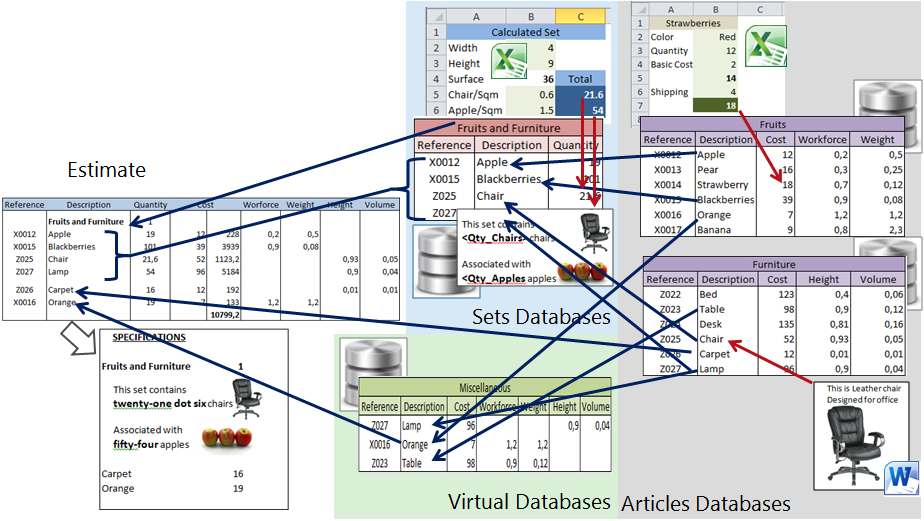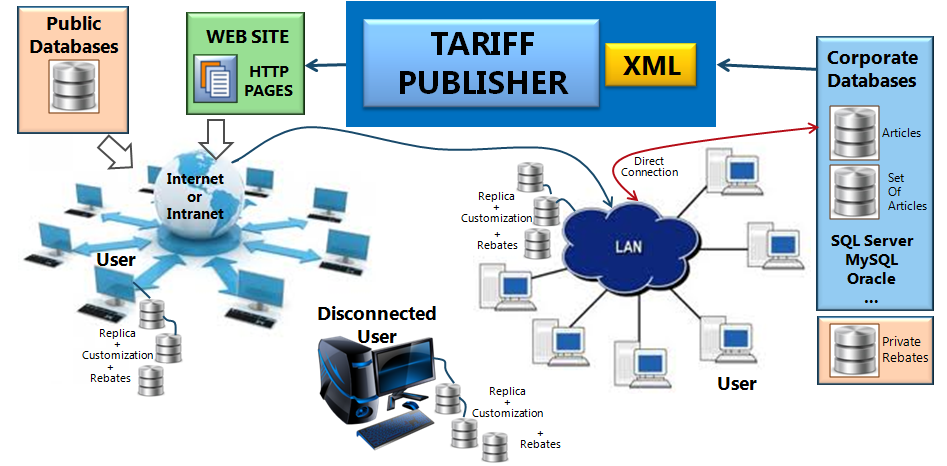A Dynamic Model
In QDV7 the source data is never duplicated. Using dynamic links and identifying a record with the Reference field, a derived value is automatically updated i.e. the modifications propagates throughout the model.
Article
A row in the Minutes view can come from a database of articles,or be recorded to a database of articles.
It can often contain not immediately visible data:
▪Excel™ workbooks can be attached to articles. They allow you to calculate thru formulas installation times, weights, cubic feet, etc
▪Word™ documents can be attached to articles. Thus technical specifications or trade documents follow the articles wherever they are invoked
This is a Set of references to various Articles located in one or more associated Article databases. The set associates one quantity for every reference. One Set can also refer to other Sets, permitting you to create a tree-structure of Articles; such a structure is usually known as a Product Breakdown Structure (PBS).
In brief, an article set is to the bidder as the article database to the manufacturer. The bidder customizes each set. The sets are grouped in set databases.
It is possible to encrypt a set database if it must be delivered.
ExcelTM workbooks can be imbedded in Article Sets. This allows you to calculate the quantities of the Articles using formulas: these quantity fields get their values from Calculated Set tables. This way, the estimating and technical computing are kept apart and the data flows the following way: Worksheet → Database → Estimate.
A Virtual Database is a database whose articles points to other databases. It is especially used to bookmark articles in one database. It is updated when the source databases are.
The estimate aggregates
▪the records coming directly from Article Databases complemented with quantities
▪the Article Sets with all the article fields
WordTM files can be imbedded in Article Databases; through aggregation and publiposting of quantities, a technical specification can be built up and appended to the estimate.

The Management module is used to build pivot-tables that sort field values according to another’s discrete values.
Databases can be of various types with various access rights:
▪Local, for private use of one user (Write)
▪Corporate, shared on a LAN, accessible thru TSE or Citrix, with an access managed by Windows (Read only or Write)
▪Public, accessible over the Internet (Read only). Examples: Bâtiprix®, meant for Construction industries in french-speaking countries (www.euroid.fr); EuroID provides public databases that can be encrypted
Protected and Public databases can be edited with some restrictions: you cannot insert articles, cannot access field manager, cannot set identity on all fields, cannot export to Excel.
Various types of databases can be mixed as sources of one estimate.
Extensions:
▪Regular bases: qdb
▪Sql bases: sqlqdb
▪Rebates bases: qdbr
Distant Databases
The databases can be remotely accessed (blue lines) by placing http requests to the server Tariff Publisher of EuroID Technologies.
The direct connection (red line) is based on InterfaceQDV.dll. Refer to CRMs and ERPs.
The public databases (Internet databases) are supplemented with Private Rebate databases, while the corporate databases (Intranet databases) include private rebates:

For details on private database, refer to Contextual Databases.
Database replica: QDV7 offers replication tools via the Internet that enable various users to use financial data synched with the central database together with specific data to their work group such as installation times, weights, power, etc. Then these specific data are stored in replica in place of the central database. These replica enable to bid in disconnected mode.
The publishing options show in How to Deploy a relational database.